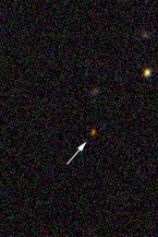Credit & Copyright: Sloan Digital Sky Survey
Explanation:
Each red speck indicated above is a
powerful quasar estimated
to be over 100 times brighter than a galaxy.
Yet in these
Sloan Digital Sky Survey discovery images the
quasars
appear faint because they are extremely distant.
Their distances have been indirectly gauged
by noting how much the light they emit
has been stretched to longer wavelengths by the
expansion of the Universe.
Because red light has the longest wavelengths in the visible
spectrum,
this stretch has come to be called "redshift" - the greater the distance,
the greater the redshift.
Astronomers use a number known as "Z" to quantify this
cosmological redshift and the
quasar at the left, with a Z of 5, was
just proclaimed the new quasar redshift champion
(from left to right the measured Zs are 5.00, 4.90, 4.75).
What's the actual
distance to quasars with Zs of 5 or so?
... about 15 billion light-years, give or take a few billion light-years
depending on your
favorite cosmology!
1999 2000 2001 2002 2003 2004 2005 2006 2007 2008 2009 2010 2011 2012 2013 2014 2015 2016 2017 2018 2019 2020 2021 2022 2023 2024 2025 |
Январь Февраль Март Апрель Май Июнь Июль Август Сентябрь Октябрь Ноябрь Декабрь |
NASA Web Site Statements, Warnings, and Disclaimers
NASA Official: Jay Norris. Specific rights apply.
A service of: LHEA at NASA / GSFC
& Michigan Tech. U.
|
Публикации с ключевыми словами:
cosmology - quasar - redshift - красное смещение - квазары - Расширение Вселенной - расстояние
Публикации со словами: cosmology - quasar - redshift - красное смещение - квазары - Расширение Вселенной - расстояние | |
См. также:
Все публикации на ту же тему >> | |
